TotheLighthouse《到灯塔去》介绍剖析
- 格式:ppt
- 大小:727.00 KB
- 文档页数:17

一、简介弗吉尼亚・伍尔夫(1882-1941),英国著名女作家,在小说创作和文学评论两方面都有卓越的贡献。
世界三大意识流作家之一,女权主义运动的先驱人物。
深受弗洛伊德心理学、女性主义及同性恋运动影响。
她在文学上的成就和创造性至今仍然产生很大的影响。
其代表作《到灯塔去》的出版成就了她在现代主义文学中的领导地位。
《到灯塔去》内容分三个部分:第一部分描写维多利亚时代家庭生活,第二部分跨越了十年的时间,最后一部分叙述一个上午所发生的事情。
主要人物拉姆齐夫人是以作者本人的母亲为生活原型的,而拉姆齐先生则有作者父亲的影子,其他人物形象也源于伍尔夫对自己家庭的回忆。
这是一部准自传体意识流小说,文中巧妙的应用了叙述手法表现小说的主题、小说的象征意义和现实意义。
意识流文学的创作高峰期基本上集中于20世纪二三十年代,美国的心理学家威廉・詹姆斯首次提出这个概念,强调的是完全面向自我,重在表现人的下意识、潜意识乃至无意识的内心世界。
小说中的意识流,是指小说叙事过程对于人物持续流动的意识过程的模仿。
具体说来,也就是以人物的意识活动为结构中心,围绕人物表面看来似乎是随机产生,且逻辑松散的意识中心,将人物的观察、回忆、联想的全部场景与人物的感觉、思想、情绪、愿望等,交织叠合在一起加以展示。
《到灯塔去》中,伍尔夫不仅完美的运用叙述手法表现时间的流逝和人的意识本质,而且还从叙述时间、叙述空间及时空结合的角度阐述了文中的主题、象征意义和现实意义。
二、《到灯塔去》中的叙述时间和叙述空间《到灯塔去》的叙述时空分析邹丹丹 广东海洋大学寸金学院外语系1. 叙述时间(1)客观时间小说中物理时间的线索十分清晰,可分成三个部分:窗;时光流逝;灯塔。
第一部分描写的是拉姆齐一家和他们几个客人的生活。
第一次世界大战前夕,拉姆齐夫妇一家和几位朋友在斯开岛上他们的海边别墅里度夏。
拉姆齐太太倚窗而立,窗外是花草树木,远处是海浪和灯塔。
地凝视着海上忽明忽暗的灯塔,陷入冥想中。

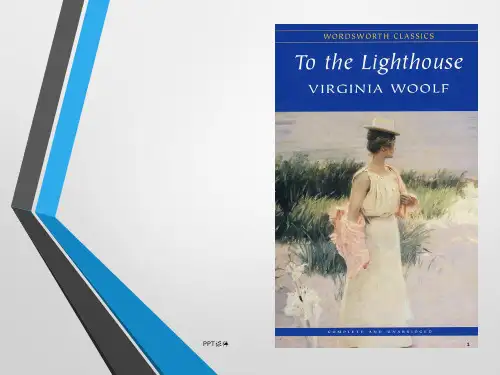
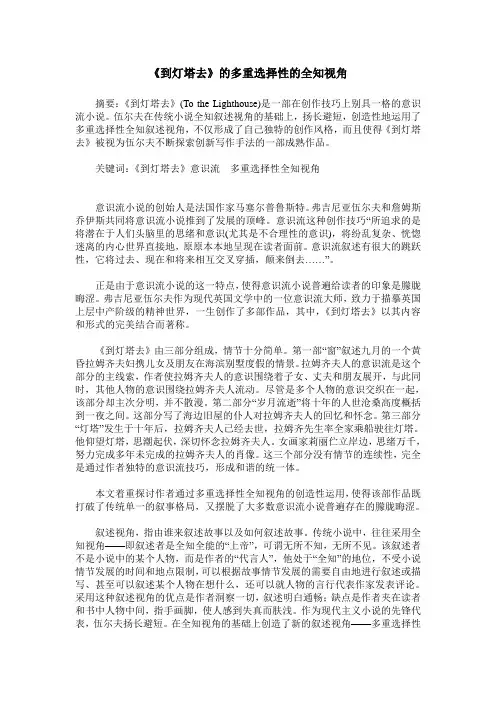
《到灯塔去》的多重选择性的全知视角摘要:《到灯塔去》(To the Lighthouse)是一部在创作技巧上别具一格的意识流小说。
伍尔夫在传统小说全知叙述视角的基础上,扬长避短,创造性地运用了多重选择性全知叙述视角,不仅形成了自己独特的创作风格,而且使得《到灯塔去》被视为伍尔夫不断探索创新写作手法的一部成熟作品。
关键词:《到灯塔去》意识流多重选择性全知视角意识流小说的创始人是法国作家马塞尔普鲁斯特。
弗吉尼亚伍尔夫和詹姆斯乔伊斯共同将意识流小说推到了发展的顶峰。
意识流这种创作技巧“所追求的是将潜在于人们头脑里的思绪和意识(尤其是不合理性的意识),将纷乱复杂、恍惚迷离的内心世界直接地,原原本本地呈现在读者面前。
意识流叙述有很大的跳跃性,它将过去、现在和将来相互交叉穿插,颠来倒去……”。
正是由于意识流小说的这一特点,使得意识流小说普遍给读者的印象是朦胧晦涩。
弗吉尼亚伍尔夫作为现代英国文学中的一位意识流大师,致力于描摹英国上层中产阶级的精神世界,一生创作了多部作品,其中,《到灯塔去》以其内容和形式的完美结合而著称。
《到灯塔去》由三部分组成,情节十分简单。
第一部“窗”叙述九月的一个黄昏拉姆齐夫妇携儿女及朋友在海滨别墅度假的情景。
拉姆齐夫人的意识流是这个部分的主线索,作者使拉姆齐夫人的意识围绕着子女、丈夫和朋友展开,与此同时,其他人物的意识围绕拉姆齐夫人流动。
尽管是多个人物的意识交织在一起,该部分却主次分明,并不散漫。
第二部分“岁月流逝”将十年的人世沧桑高度概括到一夜之间。
这部分写了海边旧屋的仆人对拉姆齐夫人的回忆和怀念。
第三部分“灯塔”发生于十年后,拉姆齐夫人已经去世,拉姆齐先生率全家乘船驶往灯塔。
他仰望灯塔,思潮起伏,深切怀念拉姆齐夫人。
女画家莉丽伫立岸边,思绪万千,努力完成多年未完成的拉姆齐夫人的肖像。
这三个部分没有情节的连续性,完全是通过作者独特的意识流技巧,形成和谐的统一体。
本文着重探讨作者通过多重选择性全知视角的创造性运用,使得该部作品既打破了传统单一的叙事格局,又摆脱了大多数意识流小说普遍存在的朦胧晦涩。

对《到灯塔去》中完美婚姻的分析在小说到灯塔去中,伍尔夫从女性角度描述了生活,婚姻,工作,思想以及之间的关系。
本文关注了伍尔夫对幸福婚姻的理解,以及丈夫和妻子怎样才能创造美满的婚姻。
根据伍尔夫的观点,幸福的婚姻要建立在爱与理解最重要的是夫妻双方要保有各自独立的空间和自由。
标签:婚姻;独立;私密空间Abstract:In the Novel To the Lighthouse,Virginia Woolf exposes a rather complicated world about life,marriage,work,thought and relationship among these from a special woman’s point view. This article focuses on Woolf’s attitudes towards the happy marriage,and for the husband and wife how to create a happy one. According to Woolf’s opinion,a happy marriage should be based on love,reverence,support and certain private space.Key Words:marriage;private space;independenceVirginian Woolf was praised as the greatest novelists of the 20th century,one of the pioneers of modern literature trends;She served on the English language innovations in novel methods of trying to stream of consciousness writing,trying to depict the heart in people’s subconscious. In her writing,she expresses her own understanding towards marriage and life,especially women’s role and self-consciousness in that society.In part one,The window,Woolf describes Mr. and Mrs. Ramsay’s happy and satisfying marriage on the basis of deep their deep love. There is a detail shows that Mr. Ramsay seized her hand and raised it to his lips and kissed it with an intensity that brought tears to her eyes,and he quickly dropped it,which reveals the deep love between the couple. The series of gentle actions expresses his profound affection. In Mrs. Ramsay’s eyes,her husband beauty was so great;he was so awfully handsome,that she couldn’t dismiss him. Marriage life is real and trivial. After getting married,a couple must face the reality and the once enthusiastic love seems gradually faded due to the distraction of the daily life. It seems so,but it is still there and can be felt. It is true for Mr. and Mrs. Ramsay. In their daily life,they know how to deal with common and trivial things,and they play different roles. For example,Mrs. Ramsay worries about the fifty pounds for the green house and children’s problems. On such occasions,Mr. Ramsay plays a very husband’s role and he can keep his wife from worries and make her feel safe and warm. When she strolled along with her husband,she felt that particular source of worry had been placed,so her husband turn up as a quiet and safe harbor for her to rest after her surge of emotions. He can,naturally,replace her worries and soothe her instantly. He convinces her of his value as a paring the husband with the wife,generally speaking,the husband is the braver and the more confident one,but sometimes so brave a man also needs the support from his wife. It was sympathy he wanted,to be assured of his genius. He hopes that his wife can bring him respect,confidence and enthusiasm towards life. That is what he wants from marriage life. And Mrs. Ramsay does play her role well. She makes the house full of warmth and vigor and fills his blank properly. There is such a detailed description to prove this. She was flashing her needles,confident,upright,she created drawing-room and kitchen set them all aglow;all her efforts make sure that her husband can go in and out,enjoy himself. So mutual love and proper roles in marriage are basic factors for a happy marriage.As for a harmonious marriage,such factors as love,reverence,support are essential,but only these can not be enough. One man and one woman get married and a family life start. Some people think one should present everything about him or her to the other one without any reserve. But the truth is that,the husband and the wife,to some extent,are still two independent individuals. They should keep their relative independence,and private space. Love can’t make a couple become one person. Each one must have his or her private room. And they,therefore,should respect each other’s privacy and keep a distance from if,especially when it refers to the spiritual world. Otherwise,the subtle mysteries and beauty of one’s privacy will be disturbed and destroyed,which certainly will do harm to his or her relationship with the other one,since on one can keep calm when one’s own treasure of privacy is trodden by others. The result is obvious:both will be hurt,so a desirable marriage,to some degree,lies in the respect for each other’s independence and privacy. Observing the rule well,The Ramsays lead a peaceful and happy life. Though Mrs. Ramsay is only a common housewife,she ha her own understanding of life. “She took a look at life,for she had a clear sense of it there,something real,something private,which she shared neither with her children nor wither her husband.” She can show disappointment at her husband’s silence when she expects he should say something. When Mrs. Ramsay loses in her own world,Mr. Ramsay could not speak to her. He could not interrupt her… she was aloof from him now in her beauty,in her sadness. He would let her be. An sometimes Mrs. Ramsay also meets such occasions:he did not want to be interrupted-that was clear. Each one should have their one private world,then the distance between them will attract and lead them appreciate each other. Since they cannot become one,then their mutual attraction will grow and the love lasts. Sometimes,the mysterious unknown of the other is hateful but it is attractive and beneficial. Based on their mutual love,trust,tolerance and acceptance,the respect for the other’s certain distance and independence will certainly add colors to one’s marriage life.On the whole,the article deals with the roles that are performed by husband and wife in marriage and the respect that should be paid to each other’s independence and privacy. And then an ideal marriage can be possibly achieved. Some feminist critics criticized Mr. Ramsay’s egotism and Mrs. Ramsay’s weakness. No one can deny this,and even Woolf herself also expressed such kind of opinion,but at the sametime no one can deny that their marriage is a satisfying one,either.Bibliography:[1]Woolf,Virginia To the Lighthouse,Wordsworth Editions Ltd,1994.[2]Freedman,Ralf. Virginia Woolf:Revaluation and Contunuity. Berkeley,Los Angeles:University Of California Fress,1975.[3] Mepham,John. Virginia Woolf:Criticism in Focus. New York:Saint,Martin’s Press,Inc.,1992。
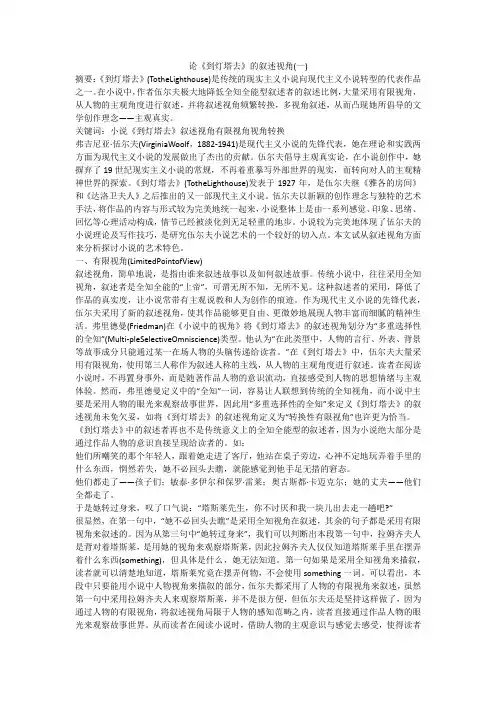
论《到灯塔去》的叙述视角(一)摘要:《到灯塔去》(TotheLighthouse)是传统的现实主义小说向现代主义小说转型的代表作品之一。
在小说中,作者伍尔夫极大地降低全知全能型叙述者的叙述比例,大量采用有限视角,从人物的主观角度进行叙述,并将叙述视角频繁转换,多视角叙述,从而凸现她所倡导的文学创作理念——主观真实。
关键词:小说《到灯塔去》叙述视角有限视角视角转换弗吉尼亚·伍尔夫(VirginiaWoolf,1882-1941)是现代主义小说的先锋代表,她在理论和实践两方面为现代主义小说的发展做出了杰出的贡献。
伍尔夫倡导主观真实论,在小说创作中,她摒弃了19世纪现实主义小说的常规,不再着重摹写外部世界的现实,而转向对人的主观精神世界的探索。
《到灯塔去》(TotheLighthouse)发表于1927年,是伍尔夫继《雅各的房间》和《达洛卫夫人》之后推出的又一部现代主义小说。
伍尔夫以新颖的创作理念与独特的艺术手法,将作品的内容与形式较为完美地统一起来,小说整体上是由一系列感觉、印象、思绪、回忆等心理活动构成,情节已经被淡化到无足轻重的地步。
小说较为完美地体现了伍尔夫的小说理论及写作技巧,是研究伍尔夫小说艺术的一个较好的切入点。
本文试从叙述视角方面来分析探讨小说的艺术特色。
一、有限视角(LimitedPointofView)叙述视角,简单地说,是指由谁来叙述故事以及如何叙述故事。
传统小说中,往往采用全知视角,叙述者是全知全能的“上帝”,可谓无所不知,无所不见。
这种叙述者的采用,降低了作品的真实度,让小说常带有主观说教和人为创作的痕迹。
作为现代主义小说的先锋代表,伍尔夫采用了新的叙述视角,使其作品能够更自由、更微妙地展现人物丰富而细腻的精神生活。
弗里德曼(Friedman)在《小说中的视角》将《到灯塔去》的叙述视角划分为“多重选择性的全知”(Multi-pleSelectiveOmniscience)类型。
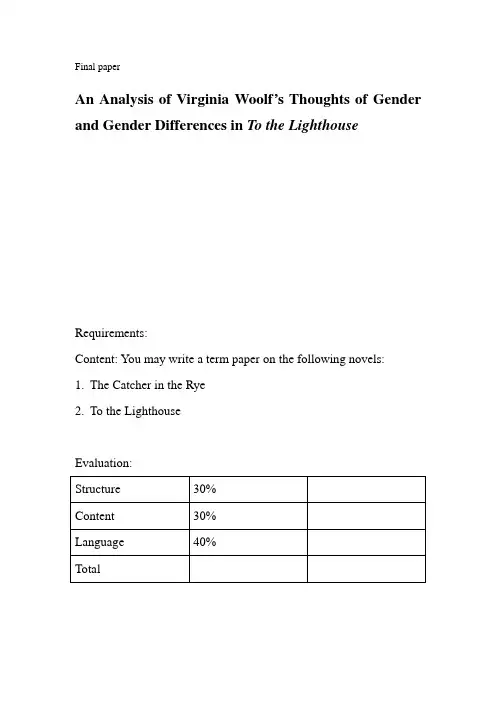
Final paperAn Analysis of Virginia Woolf’s Thoughts of Gender and Gender Differences in To the LighthouseRequirements:Content: You may write a term paper on the following novels:1.The Catcher in the Rye2.To the LighthouseEvaluation:Abstract:Virginia Woolf(1882-1941) is a renowned English writer best known for her novels and essays. To the Lighthouse is one of her great works. This paper is mainly study three issues: feminism, the understanding of gender and the thoughts of gender differences.摘要:弗吉尼亚. 伍尔夫(1882-1941)是一位以小说和散文而著名的英国作家。
《到灯塔去》是她的佳作之一。
本篇论文主要研究的三个问题是:女性主义,对于性别的理解以及有关性别差异的思考。
OutlineTitle: An Analysis of Virginia Woolf’s Thoughts of Gender and Gender Differences in To the LighthouseⅠ.IntroductionⅡ. Body:A.Woolf and feminismB.Woolf’s androgynous visionC.Gender differences1.Definition of gender difference2.Woolf’s thoughts of gender differencesⅢ. ConclusionⅠ. Introduction:Virginia Woolf was born Adeline Virginia Stephen on 25 January, 1882 inLondon. She was an English novelist and essayist, regarded as one of the foremost modernist literary figures of the twentieth century. Her most famous works include the novels Mrs. Dalloway(1925), To the Lighthouse(1927) and Orlando(1928) and the book-length essay A Room of One’s Own(1929) with its famous dictum, “ A woman must have money and a room of her own if she is to write fiction”Wang wenyan, a postgraduate of Hunan University in the paper Female Consciousness in To the Lighthouse analyzes two major female characters, Mrs. Ramsay and Lily Briscoe from the feminist criticism point of view. At first, she studies the growth of Virginia Woolf’s feminism and analyzes “Angel in the House”and “the undercurrent in Mrs. Ramsay”. This paper is very good at focusing on one topic that is Virginia Woolf’s feminism. It offers me some knowledge about feminism and makes me more familiar with this book.Cheng ying, a posts graduate from Zhengzhou University in her paper Virginia Woolf’s Art of Fiction in To the Lighthouse studies her typical stream-of-consciousness technique, musical methods, cinematic methods and poetic methods. And she mainly analyzes how these techniques used in the novel. Through reading this paper it is helpful for us to have a hint of Wool’f’s writing skills.Li songyue, a scholar of Zhengzhou University in his paper 《<到灯塔去>两性形象的象征意义阐述》he mainly studies the narrative strategy----symbolism and gender perspective. Through the comparison of different genders’ personality, action, thinking symbolic colors and finally comes out the conclusion that in the book To the Lighthouse some objects are the symbols of genders.But in this paper, what I want to study is gender and gender differences in the novel To the Lighthouse. I will talk about feminism, androgynous thoughts and genderdifferences in the novel.Ⅱ. Virginia Woolf’s Thoughts of Gender and Gender Differences in To the LighthouseA. Woolf and feminismFeminism is an intellectual, philosophical and political discourse aimed at equalrights and legal protection for women. It involves various movements, theories and philosophies, all concerned with issues of gender difference that advocate equality for women and that campaign for women’s rights and interests.Virginia Woolf’s feminist thoughts widely cover the fields of society, politics, ethics, aesthetics, etc. and the need for freedom for the female is the primary theme in her ethical scheme. Gender and politics, morality and psychological desire are mixed together inextricably in her presentation of human motivation. In spite of all of these, Virginia Woolf has never, even once in her life, admitted that she herself is an advocator for feminism and insists that what she did was just studying it. Here we can see the complexity of Woolf’s feminist position and the flexibility with which she may be read as a feminist.In To the Lighthouse, Mrs. Ramsay and Lily Briscoe are the two female figures that Woolf mainly describes. However, they impress the readers strikingly for their views about the way to realize their own dreams and to escape from nothingness. Through the reading of Woolf’s different descriptions of Mrs. Ramsay and Lily Briscoe, we may find Woolf’s thoughts of female in the novel.Mrs. Ramsay is a competent and intelligent housewife. She supports her husband by running the house smoothly and endures domestic anxiety alone so that the daily chores won’t interrupt Mr. Ramsay’s serious thoughts on reason and logic. She miraculously manages to run the house without disturbing her husband. The financial condition of the family is exposed by one of the guests, Mr. Bankes’ perception of the family. “The Ramsays were not rich, and it was a wonder how they managed to contrive it all. Eight children! To feed eight children on philosophy!” In fact, the wonder maker is Mrs. Ramsay. With herwisdom in housework she successfully shoulders the responsibility of house management without any help from her husband. Though she is worried about the household, she tries her best not to disturb him. The refrain of the bill for the greenhouse roof looms but she decides not to tell him. “She had it on the tip of her tongue to say, as they strolled, ‘It’ll cost fifty pounds,’ but instead, for her heart failed her about money, she talk ed about Jasper shooting birds …” Mrs. Ramsay feels it her obligation to keep the husband away from the worries of small daily family life.Being a good mother is another criterion of the ideal Victorian womanhood. Woolf depicts such a good mother in this novel. Mrs. Ramsay protects her children from disillusion. When her son, James hopes for a trip to the lighthouse the next day and the father declares bad weather, it is Mrs. Ramsay who insists upon the possibility of a clear day. In this way she protects the sensitive mind of the child, retaining hope and faith in him, which shows her reverence for the spirit in others. What’s more, Mrs. Ramsay also protects her children from the chaotic adult world. By intuition, she knows the world is full of misery and sufferings.Apart from Mrs. Ramsay, Lily is the other important female figure in To the Lighthouse. She admires and loves Mrs. Ramsay and shares a lot with her. However, their differences exceed their similarity. Compared with Mrs. Ramsay who is presented as an ideal woman of Victorian period, Lily represents the woman image of the new generation. She holds her unique views on marriage, which collides with the established and long standing Victorian customs of marriage. She develops her individual relationships with the opposite sex, which challenges the unitary relationship of marriage between the two sexes. She ventures into the career of painting, which has been the preserved domain of men. She courageously fights against any difficulties and obstacles that come in her way to self independence and self realization.B. Woolf’s androgynous visionAndrogyny is a term derived from two Greek words which can refer to either of two related concepts about gender: the mixing of masculine and feminine characteristics, as in fashion statements; or the balance of “anima and animus” in psychoanalytic theory. For Woolf, the psyche is composed of two parts, one male and the other female, and only when the two are fused into one will the mind be able to produce art.In Woo lf’s opinion, there exist two genders in human cerebrum –male and female and each pair forms a complementary whale. There is no apparent hierarchical order between them: the only dominance is the feminine part in the woman’s brain, and vice versa for man. Woolf’s choice of the word “fatal” is particularly important for an understanding of the high premium she places on androgyny. An importantaspect of Woolf’s argument for androgyny insists that writers should shun consciousness of their own sex when they write because pressures to conform to social gender roles create barriers that are “fatal” to creativity. She thinks that androgynous writing is not only an ideal, but also a reality. As for Woolf, “Perhaps a mind that is purely masculine cannot create, any more than a mind that is purely feminine”. She thinks that Shakespeare’s mind is a type of the androgynous of the man-womanly mind.C. Gender differences1. Definition of gender differenceThe term “gender difference” refers to a distinction of biologic al and/or physiological characteristics typically associated with either males or females of a species in general. In the study of humans, socio-political issues arise in classifying whether a sex difference results from the biology of gender. Some feminists see gender differences as caused by patriachy or discrimination, although Difference Feminism argues for an acceptance of gender differences. Conservative masculists tend to see gender differences as inherent in human nature, while liberal masculists see gender differences as caused by matriarchy or discrimination.2. Woolf’s thoughts of gender differencesWoolf’s thoughts of gender differences are formed through her understanding of the social prejudice towards all fields that related to women.There is no doubt that Woolf not only realizes the existence of gender differences and she also advocates protecting the existence. The gender differences are caused by two major aspects: the subjective social ideology that treats men and women differently and considers different genders should have different roles; and the objective existence of psychological and physical differences between different genders. These two aspects are respectively subjective cause and objective cause. In conclusion, the essence of Woolf’s thoughts of gender differences is: 1) admission of the existence of gender differences, in both subjective and objective aspects; 2) opposition to the subjective and prejudiced thoughts of genderdifferences; and 3) promotion of the objective gender differences and encouragement of the existence of such differences.In To the Lighthouse, Woolf presents clear portraits of male and femalecharacters. The characters she describes most carefully are Mr. Ramsay and Mrs. Ramsay. In the novel, the both Mr. Ramsay and Mrs. Ramsay want to create a harmonious atmosphere among people and try to be understandable to others. However, they have different outlooks on life and their attitudes and behaviors are also significantly different.In To the Lighthouse, Virginia Woolf discusses the influence of the traditional conception about different genders, which is the cause of gender differences. Mrs. Ramsay in the novel is the typical woman who is the slave fostered by men. Although she is not satisfied with the life of losing herself and lacking for self-confidence, she still worships her husband blindly, depends on her husband and subordinates to her husband. Besides playing the role of a virtuous wife and a lovely mother initiatively in the family and an elegant hostess in social situations, she still makes use of her influential power. Mrs. Ramsay does not only comply with social customs herself, she also impels others: she arranges for the marriage between Paul and Minta and tries to persuade Lily to marry Mr. Bankes. Under the influence of such traditional conception about different genders, Lily still feels that she can’t get rid of social prejudice to concentrate her attention on the art of painting although she is a woman having her own inclination. She always feels that she is just a second-class painter, and her works will not be hung on the wall to be seen by people. Furthermore, there is Mr. Tansley whispering in her ear, “Women can’t paint, women can’t write” obvious that her feeling of failure is caused by the influence of the traditional conception about different genders that women are inferior to men.Another great difference between different genders is that Mr. Ramsay is more realistic while Mrs. Ramsay more idealistic. This can be seen, in the very beginning of the novel, from the attitudes towards whether the Ramsays can go to the lighthouse the next day. Mrs. Ramsay says: “Yes, of course if it’s fine tomorrow, but you’ll have to be up with the lark,” then they will go to the lighthouse. These words convey an extraordinary joy to her son. But her husband comes over and refutes: “But, it won’t be fine”. What he says is the truth and the truth forever; he does not resort to deception and distort the fact, and he will not say some harsh words mildly and indirectly to satisfy others. Mrs. Ramsay comforts James: “But it may be fine –Iexpect it will be fine” (ibid.: 260). Although she has no idea about the weather of thenext day, Mrs. Ramsay is not only idealistic herself, but also wants to give her son comfort and hope. Mr. Ramsay, on the other hand, is not only rational as mentioned before, but also realistic, directly telling his son that the weather will not be fine and they can’t go to the lighthouse the next day. To Mr. Ramsay, the reality towers abo ve the rest, i.e., it’s much more important to respect the facts than to care for children. Therefore, his little son James is even anxious to kill him. As a philosopher, he may be skilled at explaining and dealing with everything in the world with his sense and logic. However, when he applies this kind of attitude to real life, such attitude seems so stubborn that he even denies human nature and suppresses others’ feeling, not only in his learning, but also in dealing with human relationship.The third difference between different genders lies in the aesthetic appreciations. Mr.Ramsay can’t feel the beauty of nature at all. In this novel, male characters come into society,engaging in scientific study. Thinking themselves as the creators of the culture, men talk about science and politics. Yet being deprived of the rights to receive education, women have to stay at home and stand beyond culture. Mr. Ramsay and Mrs. Ramsay have different reactions to the scenes of nature. For example, when Mr. Ramsay has a wal k with his wife by the seaside“he thought, looking at the land dwindling away… Poor little place,” but Mrs. Ramsay considers, “He said the mostmelancholy things,” and believes that “it was a perfectly lovely evening”.Ⅲ. ConclusionOn the whole, this dis sertation expounds on Virginia Woolf’s thoughts of gender and gender differences through the analysis of her thoughts of feminism manifested in her novel To the Lighthouse. From our analysis of the characters in the novel To the Lighthouse, we can see that Woolf’s perspective of women is unique. According to Woolf, women are not inferior to men in any field.In my opinion, the basis of Virginia Woolf’s androgynous theory has something in common with her thoughts of gender differences to a certain extent. Androgynous theory advocates that men and women command the chaotic world in their own way: men rely on their reason and logic; women rely on their intuition and self-awareness. In fact, what Woolf insists as part of her thoughts of gender differences is that mentend to be more reasonable than women and women more sensitive than men. In addition, Woolf’s thoughts of gender differences can be regarded as a bridge, connecting Woolf’s thoughts of feminism and androgynous vision.Virginia Woolf’s thoughts of wom en still have practical significance in our modern society. Nowadays, women’s social position has been greatly improved, but there are many unfair treatments of women in the society, especially in finding jobs. There are many women isolated in their families after marriage, which is partly caused by their insufficient confidence in themselves. So it is time to get rid of the biased thoughts of gender differences about women and women themselves should believe that they can do many things like men. However, as a matter of fact, women should realize that they have both advantages and disadvantages. In this sense, women should not reject all male qualities and they need to absorb some male qualities to become perfect ones. In this way, women and men can draw the strong points of others to offset their own weakness, so that our society can get a harmonious development. In short, Virginia Woolf has made a great contribution to English literature and she will always be remembered as one of the most prominent women writers in England forever.Reference[1] 程英. Art of Fiction in To the Lighthouse [D].郑州:郑州大学,2002[2]李嵩岳. 《到灯塔去》两性形象的象征意义阐述[D]. 郑州,郑州大学,2009 [2] 吴庆宏. 弗吉尼亚伍尔夫与女权主义[M]. 北京: 中国社会科学出版社, 2005.[4]. 王文艳. 《到灯塔去》中的女性意识[D].长沙:湖南师范大学,2001。

摘要:《到灯塔去》(To the Lighthouse)是一部经典的意识流小说,它以完美与和谐的艺术形式充分展示了弗吉尼亚·伍尔夫(Virginia Woolf)非凡的艺术功力。
从女性文化的角度去解读它,我们不难发现女性文化的精粹就是爱与美。
小说中的女主人公——拉姆齐夫人(Mrs.Ramsay)是一位集爱与美于一体的圣母玛丽亚式的母亲。
尽管长期以来,女性文化一直受到男权中心的文化的压抑和忽视,但是由于女性文化具有非同寻常的同化力,对男性世界和整个人类命运,都产生了悠久而深刻的影响,在《到灯塔去》这部小说中,弗吉尼亚·伍尔夫通过对女性之爱的圣颂来消解男权中心的文化布置下的冷酷、孤独、焦虑、彷徨和虚无。
关键词:女性文化;男权文化;女性之爱;女性精神;博爱《到灯塔去》(To the Lighthouse)是英国著名女作家弗吉尼亚·伍尔夫(Virginia Woolf)倾注心血的一部意识流小说,它主要反映了二战前后社会的变迁和动荡带给现代西方人的迷茫、孤独、焦虑、彷徨、悲哀和虚无。
但笔者以为,作为一位富有敏锐洞察力而又才华横溢、不乏哲理思辩力的女作家,弗吉尼亚·伍尔夫在小说中同时还执着于对女性生命存在的价值及其方式的探索。
《到灯塔去》是以弗吉尼亚·伍尔夫童年的生活经历为基础,是一部自传体小说。
小说中的主人公——拉姆齐(Ramasy)夫妇是作者父母的化身。
拉姆齐夫人是一位有八个孩子的母亲,她集博爱与美于一身,具有圣母玛丽亚式的宽广胸怀。
博爱——是拉姆齐夫人所具有的爱的本能:她爱丈夫、爱孩子、爱朋友、爱她在路上碰到的素昧平生的穷人,也爱诡异的自然。
她的爱是发自内心的,不带任何政治色彩。
这种爱是人类最本质的爱,她的爱使人们的内心充满了温暖、和谐和柔情,使人们的心融到了一起,使人们内心的仇恨、孤独和浮躁都冰消瓦解了。
灯塔世界中的拉姆齐夫人充满着生命的活力,体内的能量仿佛在不断地溢出,化为一股强大的精神力量;她又象一股喷泉,不时进发出一阵阵爱的甘霖。

论《到灯塔去》的叙事艺术【摘要】《到灯塔去》是一部叙事艺术精湛的小说,其情节展开与发展巧妙地吸引读者,人物形象生动鲜明,叙述风格独特,环境描写真实细致,读者情感被巧妙地引发。
作者通过这些方面的表现,使得整部作品充满魅力。
这部小说的叙事艺术值得称赞,不仅展示了对文学创作的深刻理解和掌握,还影响着读者的心灵。
通过对作品中种种成功之处的剖析,我们可以获得有关文学创作的启示,从中汲取灵感,提升自己的写作水平。
《到灯塔去》的艺术魅力正是因为其叙事细腻入微,人物形象生动饱满,以及对情感和环境的真实描绘。
这部作品让读者感受到了深深的共鸣与启发,展现出了极高的文学价值。
【关键词】关键词:《到灯塔去》、叙事艺术、小说情节、人物形象、叙述风格、环境描写、读者情感、值得称赞、文学创作、心灵影响1. 引言1.1 论《到灯塔去》的叙事艺术《到灯塔去》是英国作家弗吉尼亚•伍尔夫的代表作之一,被誉为20世纪最重要的文学作品之一。
这部小说以其独特的叙事艺术吸引了无数读者,引发了深刻的思考和感悟。
在小说中,作者通过细腻的笔触和独特的叙述方式,展现了人物内心的挣扎与成长,描绘了自然环境的变幻和壮美,打动了读者的心灵。
《到灯塔去》以情节的展开与发展为主线,巧妙地构建了一个家庭的故事,展现了人物之间复杂的关系和情感纠葛。
作者通过细腻的描写和情感的抒发,使得读者能够深入地理解每个角色的心理活动,感受到他们的内心挣扎和生活困境。
人物形象的刻画是《到灯塔去》的一大亮点,每个角色都有自己独特的性格和个性,栩栩如生地呈现在读者面前。
通过对人物形象的生动描绘,作者成功地展现了人性的复杂性和多样性,引发了读者对人物命运的共鸣和思考。
叙述风格的独特性是《到灯塔去》的另一大特点,作者运用了现代主义的叙述技巧,采用流畅而抽象的语言,使得整个故事充满了诗意和意境。
读者可以通过作者独特的叙述方式,感受到情感的冲突和美学的追求,进而深入思考生命的意义和存在的困境。
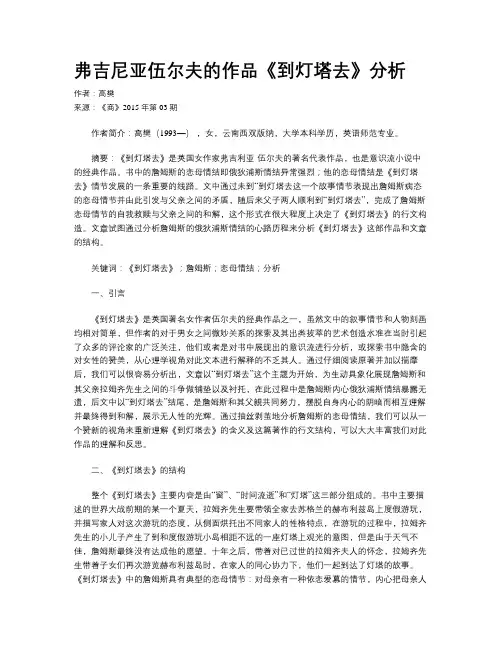
弗吉尼亚伍尔夫的作品《到灯塔去》分析作者:高樊来源:《商》2015年第03期作者简介:高樊(1993—),女,云南西双版纳,大学本科学历,英语师范专业。
摘要:《到灯塔去》是英国女作家弗吉利亚·伍尔夫的著名代表作品,也是意识流小说中的经典作品。
书中的詹姆斯的恋母情结即俄狄浦斯情结异常强烈;他的恋母情结是《到灯塔去》情节发展的一条重要的线路。
文中通过未到“到灯塔去这一个故事情节表现出詹姆斯病态的恋母情节并由此引发与父亲之间的矛盾,随后来父子两人顺利到“到灯塔去”,完成了詹姆斯恋母情节的自我救赎与父亲之间的和解,这个形式在很大程度上决定了《到灯塔去》的行文构造。
文章试图通过分析詹姆斯的俄狄浦斯情结的心路历程来分析《到灯塔去》这部作品和文章的结构。
关键词:《到灯塔去》;詹姆斯;恋母情结;分析一、引言《到灯塔去》是英国著名女作者伍尔夫的经典作品之一,虽然文中的叙事情节和人物刻画均相对简单,但作者的对于男女之间微妙关系的探索及其出类拔萃的艺术创造水准在当时引起了众多的评论家的广泛关注,他们或者是对书中展现出的意识流进行分析,或探索书中隐含的对女性的赞美,从心理学视角对此文本进行解释的不乏其人。
通过仔细阅读原著并加以揣摩后,我们可以很容易分析出,文章以“到灯塔去”这个主题为开始,为生动具象化展现詹姆斯和其父亲拉姆齐先生之间的斗争做铺垫以及衬托,在此过程中是詹姆斯内心俄狄浦斯情结暴露无遗,后文中以“到灯塔去”结尾,是詹姆斯和其父親共同努力,摆脱自身内心的阴暗而相互理解并最终得到和解,展示无人性的光辉。
通过抽丝剥茧地分析詹姆斯的恋母情结,我们可以从一个赞新的视角来重新理解《到灯塔去》的含义及这篇著作的行文结构,可以大大丰富我们对此作品的理解和反思。
二、《到灯塔去》的结构整个《到灯塔去》主要内容是由“窗”、“时间流逝”和“灯塔”这三部分组成的。
书中主要描述的世界大战前期的某一个夏天,拉姆齐先生要带领全家去苏格兰的赫布利兹岛上度假游玩,并描写家人对这次游玩的态度,从侧面烘托出不同家人的性格特点,在游玩的过程中,拉姆齐先生的小儿子产生了到和度假游玩小岛相距不远的一座灯塔上观光的意图,但是由于天气不佳,詹姆斯最终没有达成他的愿望。

外国文学研究odern chineseMXIANDAI YUWEN2008.059520世纪初,动荡不安的英国社会在政治、经济、文化、意识形态等方面都陷入深刻的危机之中,人们的思维方式以及社会生活的各个层面都经历着巨大的转变。
文学方面,现代主义迅速崛起,形成一股反现实主义的文学浪潮。
弗吉尼亚・伍尔夫(Virginia Woolf,1882—1941)是现代主义小说的先锋代表,她在理论和实践两方面为现代主义小说的发展做出了杰出的贡献。
《到灯塔去》(To the Lighthouse)发表于1927年,是伍尔夫继《雅各的房间》和《达洛卫夫人》之后推出的又一部现代主义小说,此部小说较为完美地体现了伍尔夫的小说理论及写作技巧,是研究伍尔夫小说艺术的一个较好的切入点。
一、主观真实在小说创作中,伍尔夫倡导主观真实论,她摒弃了19世纪现实主义小说的常规,不再着重摹写外部世界的现实,而转向对人的主观精神世界的探索。
伍尔夫认为,客观世界的人和事远远不是全部的真实,人们内心深处的各种印象与回忆是比客观世界更本质的真实。
她在《一间自己的房间》中指出:“真实就是把一天的日子剥去外皮之后剩下的东西,就是往昔的岁月和我们的爱憎所留下的东西。
”①(p169)可以说,伍尔夫眼中的真实其实是一种主观的真实。
《到灯塔去》较为完美地体现了伍尔夫一贯倡导的主观真实论。
在作品中,伍尔夫大量运用间接方式的内心独白,作者不再从自身立场叙述,而是通过作品中不同人物的主观角度进行叙述,其内容是人物的观念与感觉,而非作者自己的想法。
小说中,拉姆齐夫人听到丈夫和塔斯莱的谈话声突然中断,心境陡然变化,原先的宽慰心情在瞬间被“一阵恐惧的冲动”②(p16)所代替。
海浪声也从“有规律的,镇定的节拍”②(p16)变得“象雷声一般在她的耳际轰鸣”。
②(p16)伍尔夫就是这样善于通过描写人物的印象、回忆和幻想等,让读者能够清晰把握人物心理上的细微变化,从而体现她所追求的真实。
评弗伍尔夫《到灯塔去》的意识流技巧一、本文概述本文旨在深入探讨弗吉尼亚·伍尔夫(Virginia Woolf)的经典小说《到灯塔去》(To the Lighthouse)中所运用的意识流技巧。
弗吉尼亚·伍尔夫作为20世纪英国文学的重要人物,以其独特的写作风格和技巧,尤其是意识流手法的运用,为现代小说的发展做出了重要贡献。
在《到灯塔去》这部作品中,她巧妙地运用意识流技巧,将人物内心的复杂情感和思维过程以流动、自由的形式展现出来,使得小说呈现出一种独特的艺术魅力。
本文将首先概述《到灯塔去》的基本情节和主题,进而分析伍尔夫如何通过意识流技巧来展现人物的内心世界。
随后,本文将详细探讨伍尔夫在小说中运用的各种意识流手法,如内心独白、自由联想、时间跳跃等,并分析这些手法如何增强作品的艺术效果。
本文将总结伍尔夫意识流技巧在《到灯塔去》中的成功运用,以及这些技巧对现代小说创作的启示和影响。
通过本文的探讨,读者将能够更深入地理解弗吉尼亚·伍尔夫的创作风格和意识流技巧在小说中的运用。
二、弗伍尔夫与意识流文学弗伍尔夫(Virginia Woolf)是20世纪英国文学史上的一位杰出女作家,她的作品以独特的风格和深刻的主题而著称。
在弗伍尔夫的创作中,她深受意识流文学的影响,并在自己的作品中巧妙地运用了意识流技巧。
意识流文学作为一种重要的文学流派,强调对人物内心世界的深入探索和表现,而弗伍尔夫则通过意识流技巧将这种探索推向了极致。
弗伍尔夫的作品中,意识流技巧的运用主要体现在对人物内心世界的细腻描绘和展现上。
她通过对人物内心意识的流动、交织和变换进行深入的刻画,使读者能够更加真实地感受到人物的内心世界和情感变化。
这种描绘方式不仅突破了传统叙事模式的限制,也使得作品更加具有艺术性和感染力。
在《到灯塔去》这部作品中,弗伍尔夫通过意识流技巧的运用,将人物内心的情感变化与外部环境的变化相互交织,形成了一种独特的叙事结构。
论《到灯塔去》的象征艺术【摘要】《到灯塔去》这部小说是一部充满象征意义的作品,其中的灯塔、海、光线、孤独和航标等元素被赋予深刻的象征意义。
作者通过这些象征来探讨人生的意义、追寻内心的真实和抗拒现实的挑战。
灯塔象征着希望和指引,海象征着无限可能和未知,光线象征着真理和启示,孤独象征着内心的孤独和挣扎,航标象征着前行的方向和目标。
通过对这些象征的分析和解读,我们可以更好地理解小说中的含义,探讨现实与理想的关系,并发现作品的深厚艺术价值。
《到灯塔去》不仅是一部文学作品,更是一部思想的探索和灵魂的启示。
【关键词】《到灯塔去》,象征艺术,灯塔象征,海象征,光线象征,孤独象征,航标象征,艺术价值,现实联系,总结。
1. 引言1.1 《到灯塔去》的背景介绍《到灯塔去》是英国作家弗吉尼亚·伍尔夫(Virginia Woolf)于1927年出版的小说,是她的代表作之一。
这部小说以灯塔为主要场景,讲述了一家人在灯塔度假的故事。
灯塔是指一座位于海岸边的巨大建筑物,用来引导航海者航行。
在小说中,灯塔象征着远方的希望和理想,也代表着人们对未来的向往和探索。
作者通过描绘灯塔的景象和意义,展现了人类对于事物意义和存在的追求。
《到灯塔去》在当时引起了广泛的关注和好评,被认为是一部充满象征意义和思考的文学作品。
作品中描绘的家庭生活、人际关系以及对自我和外部世界的探索,都体现了作者对人类内心深处和情感世界的敏锐洞察力。
通过对灯塔的象征化处理,作者使得小说中的人物和情节更加深刻和丰富,给读者留下了深刻的印象。
《到灯塔去》的背景介绍为读者提供了对小说整体主题和意义的初步了解,也为后续正文中具体象征意义的探讨奠定了基础。
1.2 《到灯塔去》的作者简介《到灯塔去》的作者是英国作家弗吉尼亚·吴尔夫(Virginia Woolf)。
吴尔夫生于1882年,在20世纪初是一位备受瞩目的现代主义作家。
她以其独特的文体和对人类内心深处的刻画而闻名于世,被认为是20世纪英国文学史上最伟大的小说家之一。
英语一班邓亚琼201213010101To the LighthouseThere are many different points between to the Lighthouse and other traditional novels I have read. I got some ideas from this novel。
First,the content is simple but complicated。
There are only three plots in this novel:a dusk,time lost,and to the lighthouse。
The time span of the first plot is only half of day but it costs more then one third of the whole novel。
This part describes what happened to the Ramseys and their friends. What scene impressed me most is that the dinner for fifteenth people。
Mrs Ramsey prepared the dinner carefully. Her always makes allowance for every people in the table. She detected the upset feelings and self—abasement of Charles Tansley。
She made an eye connection with Miss Lily to show her wish that Miss Lily can comfort Tansley by communicating with him. She can make all the people be in a harmonious atmosphere.Obviously she has a gift of harmonization and communication. Mrs Ramsey is like the lighthouse in the sea, warming hearts of every one. Her husband’s heart suffering from setback and barrier of getting no success absorbscomforts,relaxations, and recovery from her; in her children’s eyes,she is a kind mother,who always said “I will protest you” and cherish their immature heart;as well as friends can get help from lives and comfort from mental side。
浅析《到灯塔去》中伍尔夫对于生命和谐意义的探求(渤海大学文理学院外语系)摘要:意识流小说作家弗吉尼亚·伍尔夫的代表作品《到灯塔去》,通过复杂变换的人物心独白描写等意识流表现手法让人们感受到了意识流小说饱满的思想。
本文旨在通过侧重分析作者通过对中心人物拉姆齐夫人对于和谐的追寻,进一步使读者对于伍尔夫以及这部《到灯塔去》的主题思想有更深的认识与理解。
关键词:弗吉尼亚·伍尔夫;意识流;《到灯塔去》;和谐一、引言著名的英国女小说家弗吉尼亚·伍尔夫,被誉为20世纪现代主义与女性主义的先锋人物之一。
她在文学上的成就和创新影响至今。
伍尔夫的作品颇多,《到灯塔去》是她著名代表作之一,几乎所有的人物事件以及场景,都带有浓重的象征色彩和形式。
众多评论家从不同角度对其进行分析与评价。
笔者基于其他文献的基础上,仅做出自己的简单解析,本文从拉姆齐夫人对拉姆齐先生,塔斯莱先生,以及对莉莉的影响这三点来解读这部作品体现出的作者对于生命和谐的意义的追求。
首先,对于意识流小说、作家本人做一个简单的介绍。
二、意识流小说、作家生平简介早在1918年,意识流作为一个心理学词汇被梅·辛克莱引入文学界。
在这之后,“意识流文学”就泛指注重描绘人物意识流动状态的文学作品。
在创作上,意识流文学主要特点包括着重现人的心世界,所追求的就是潜藏于人们头脑里的思绪和意识,旨在将纷乱复杂、恍惚迷离的心世界直接地、原原本本地呈现在读者面前。
意识流动的特点是,往往由现在的某一情景引起,触发对过去某一相似(往往只是在某一局部上相似)情景的联想,或诱发对未来某种情景的向往。
通常采用心独白、心分析、自由联想、多角度叙事和象征的表现手法,并借回忆、现实、幻想、梦境等交织组合,令人印象深刻。
弗吉尼亚·伍尔夫(1882-1941)是西方意识流小说作家的杰出代表之一。
“意识流”小说的诸多写作特征,被伍尔夫运用的淋漓尽致。
她阐释“意识流”小说观点的论文《论现代小说》已经透彻地表明了自己对于意识流小说的深刻理解。